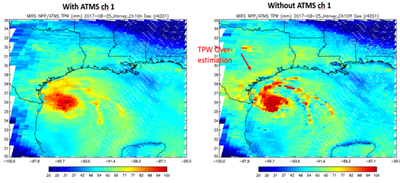Using Satellite Microwave Data for Water Vapor

Figure: Impact of removing ATMS channel 1 (23.8 GHz) on the retrieval of total precipitable water (TPW) by NOAA's Microwave Integrated Retrieval System (MiRS). The case shown is of Hurricane Harvey in August 2017. Without ATMS ch1, TPW is overestimated.
© NOAA/NESDIS
CISESS scientists Chris Grassotti and Yong-Keun Lee were coauthors along with NOAA STAR scientists Quanhua (Mark) Liu and Changyong Cao of a paper published on January 30, 2021 in the open access journal Remote Sensing. The paper titled "How Can Microwave Observations at 23.8 GHz Help in Acquiring Water Vapor in the Atmosphere over Land?" examined the role of the microwave channel at 23.8 GHz in obtaining total integrated water vapor over land. The question arises because while single channel measurements from this channel are very effective in obtaining integrated water vapor over the ocean, they do not provide great sensitivity over land due to the much higher emissivity of land surfaces. Furthermore, when measurements from this channel are excluded from multichannel satellite retrieval algorithms, the accuracy of the total water vapor estimates is reduced (see Figure).
The analysis showed, however, that over land the sensitivity of this single channel to lower tropospheric water vapor is still high, and when used in combination with measurements in other microwave frequencies that are sensitive to upper tropospheric water vapor, accurate estimates of total water vapor are still possible. This study was motivated by concerns about the rapid development and deployment of 5G telecommunications technology, which operates in frequencies very close to 23.8 GHz and which could pose a risk of interference in the passive microwave measurements.
Liu, Q.; Cao, C.; Grassotti, C.; Lee, Y.-K. How can microwave observations at 23.8 GHz help in acquiring water vapor in the atmosphere over land? Remote Sens. 2021, 13, 489. https://doi.org/10.3390/rs13030489
« Back